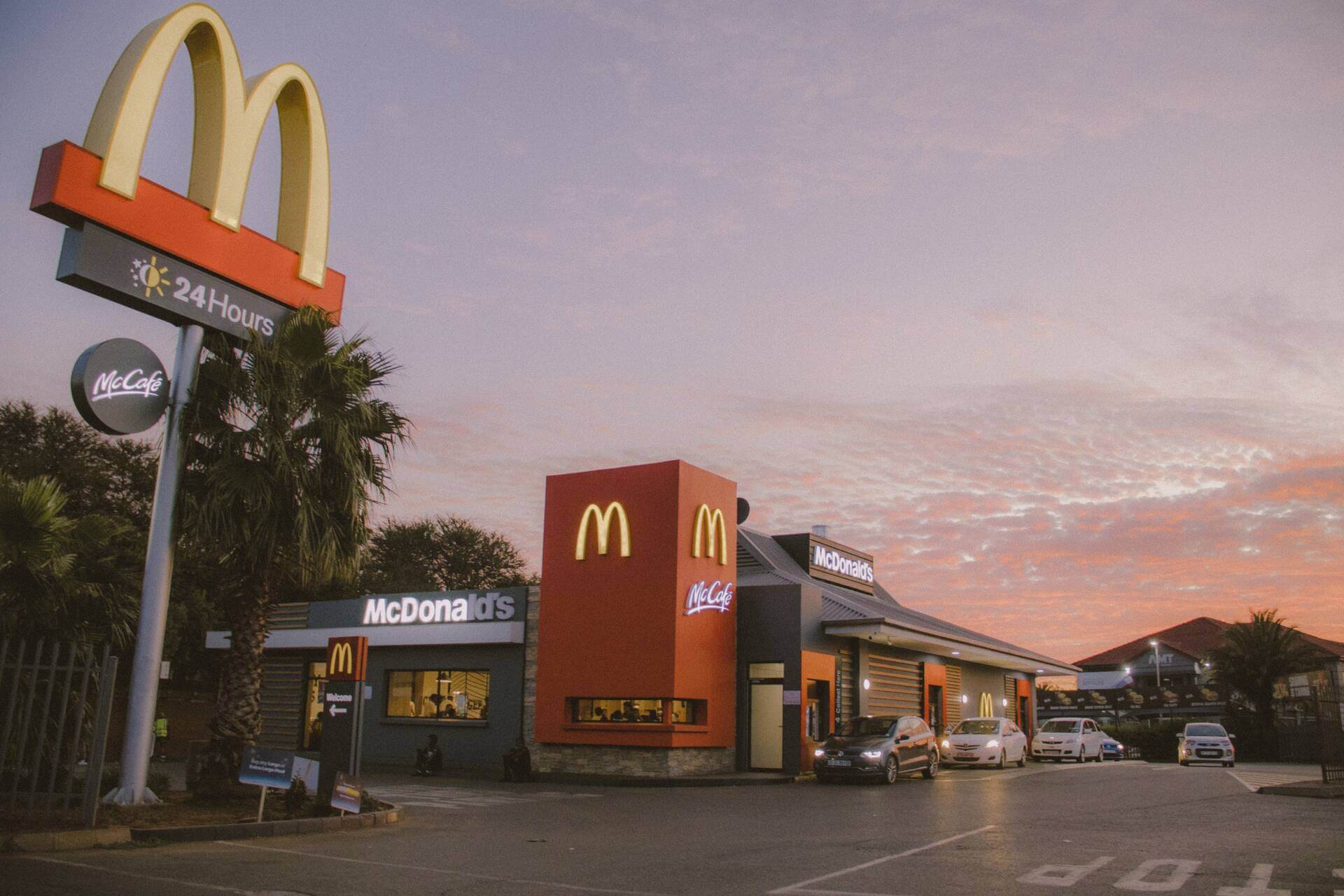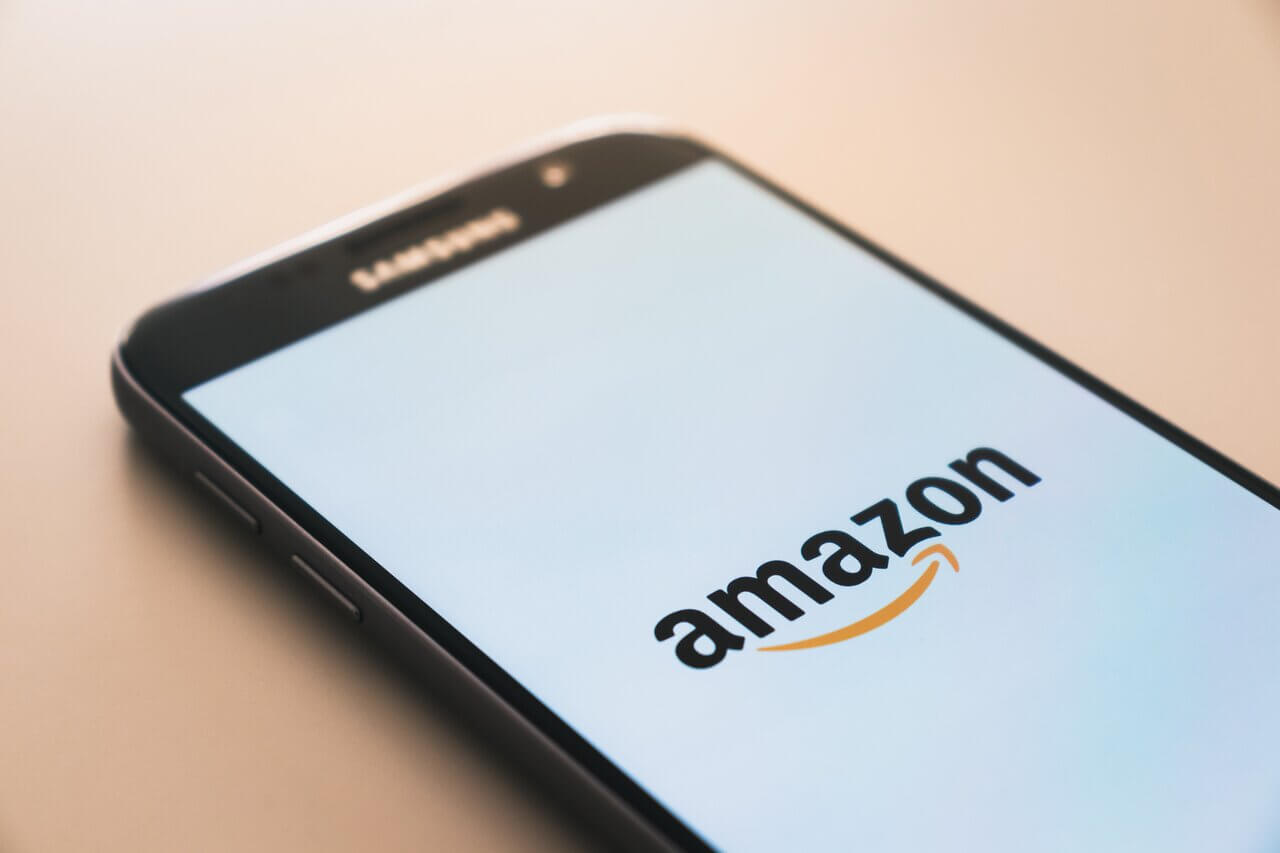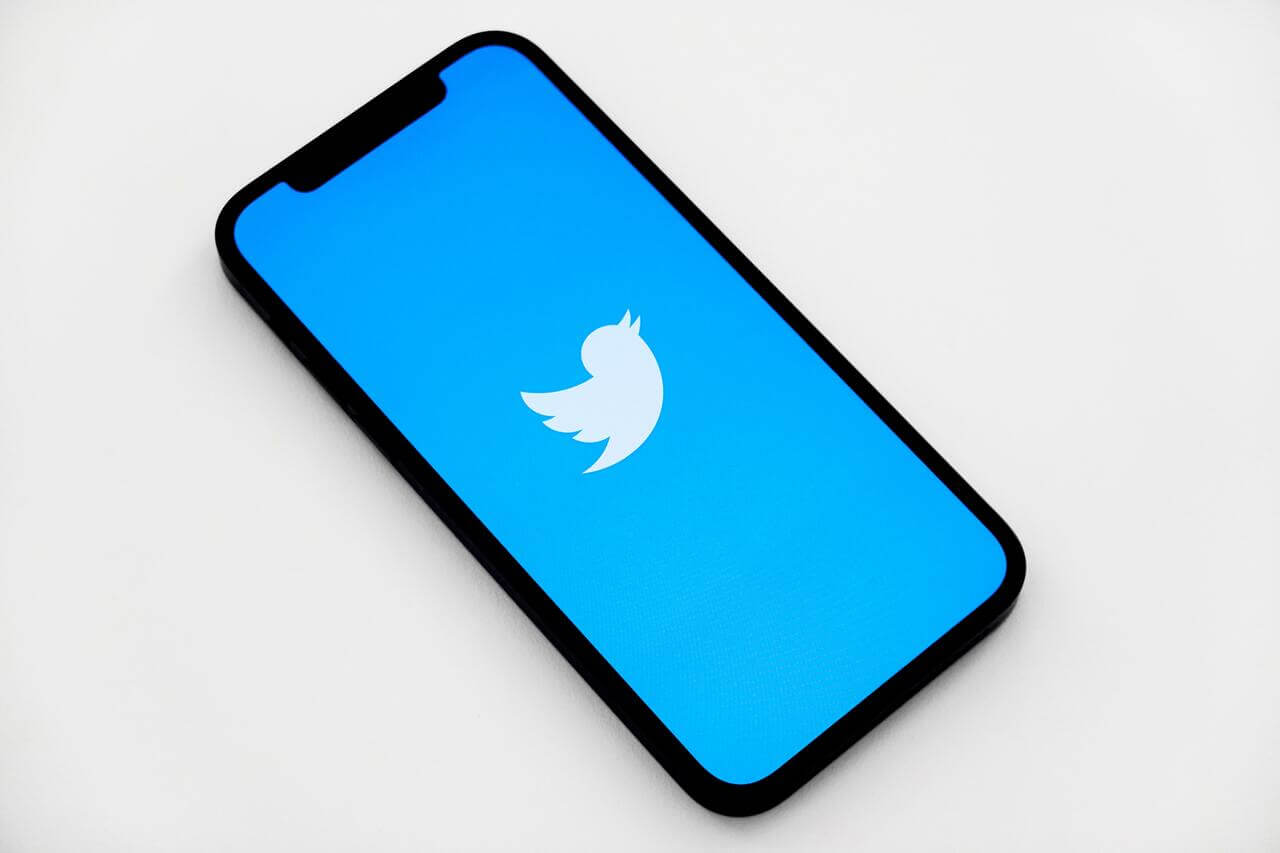From selling shoes from the back of a car to a Sportswear Giant
The Nike swoosh has become a symbol of excellence and success around the world. Standing tall among competitors in the industry, this uncontested giant has built itself up through larger-than-life marketing campaigns, high-profile endorsements, and stylish designs.
With famous brand ambassadors such as Lebron James, Tiger Woods, and Michael Jordan, the Nike brand was valued at approximately 34.8 billion U.S. dollars in 2020. Named after the Greek goddess of victory, Nike has been the number one sports footwear for decades.
But this high level of success didn’t come from anywhere. In fact, Nike had pretty humble beginnings but what was clear from the start was the drive to offer athletes a better shoe. This core principle has been the basis of all Nike designs from 1962 till today.
So how exactly did Nike become successful? What challenges did it face, and what made it different from other sport footwear manufacturers? Let’s roll it back to the time of bell-bottoms, tie-dye t-shirts, and go-go boots.
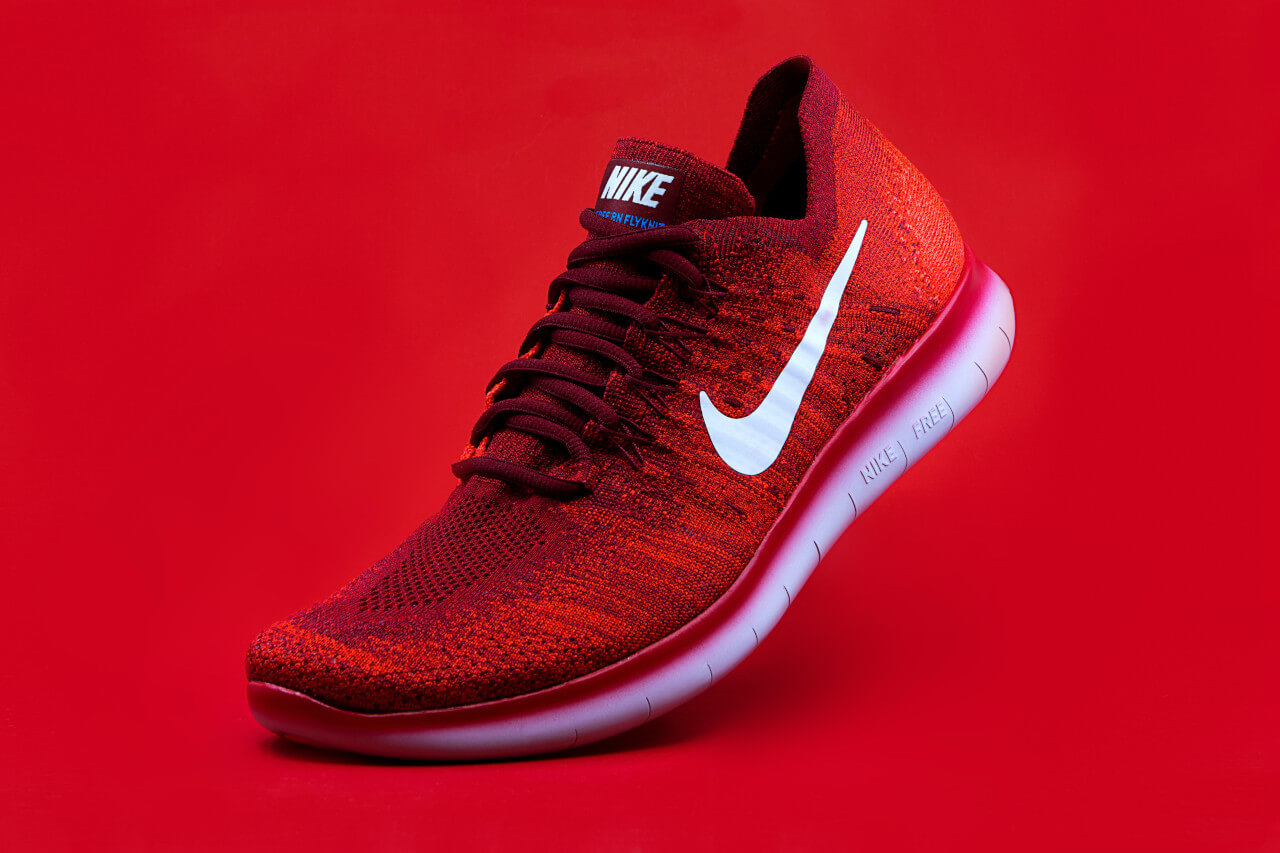
1962-1970: The birth of Nike as Blue Ribbon Sports
1962-1962: How the idea of Nike was born
It’s 1960, and Phil Knight, an average track runner at the University of Oregon, has graduated and is looking for his next opportunity. As part of the track team, he had been coached by Bill Bowerman, who was famous for producing star athletes.
Bill had one particular skill that would prove to be crucial to the birth of Nike. He was fascinated by the idea of tweaking and customizing his runner’s shoes for optimum performance. He had learned the skill from a local cobbler. Bowerman was obsessed with the connection between design and speed in all his improvements. His students preferred his custom designs, and Knight was one of them.
Knight enrolled at Stanford University for an MBA Program and wrote a paper analyzing the production costs of running shoes in Germany. His proposal was based on the theory that production should be moved to Japan, where labor was cheaper.
He had noticed that Japanese camera manufacturers had made some significant improvements to their products. These improvements had made the Japanese cameras so popular they had started to take a considerable chunk of the American market from the dominant German camera brands. Knight figured that Japanese athletic shoes could have the same effect on Adidas which was dominating the U.S. market at that time.
After graduating from Stanford, the idea from his paper kept nagging at him. He had written several letters to different Asian manufacturers with a proposal to become their sole distributor in the U.S. but got no response.
The plane ride that changed the world of sports footwear
As soon as he could, he hopped on a plane to a little town called Kobe in Japan, where he found Onitsuka Co. This company was producing quality and very popular shoes called the Tiger. Knight knew that he had to present a professional front so when he spoke with the owner, he lied that he already had a company called Blue Ribbon Sports. His tactic worked and the owner agreed to make him the sole distributor of the shoes in the U.S.
After returning to America in November 1962 with just 12 pairs of the Onitsuka Tiger, Knight started going to different sporting events to sell the shoes out of his car. He had some success but soon realized that he needed help to make his idea scalable.
He reached out to his old coach Bill Bowerman and pitched his idea. Bowerman was immediately taken in and entered into a 50-50 ownership deal for a distribution company called Blue Ribbon Sports.
1964-1970: Blue Ribbon Sports & the Struggle for Cash
In January 1964, Blue Ribbon Sports was officially incorporated. Bowerman and Knight invested $500 each for their first order and got about 300 pairs of shoes. They knew there was a market for these cheaper high-quality alternatives. However, the market was still dominated by famous brands like Adidas and Puma.
Knight and Bowerman didn’t have enough capital to order the shoes they needed from Japan, so Knight got a loan from his father. Later that year, the two managed to secure their first commercial loan of $3,000 from the First National Bank of Oregon. This line of credit helped them to pre-order enough shoes to meet demand.
Meanwhile, Bowerman decided to use his fascination with speed and design to good use. When their first order arrived, he ripped the Tiger shoe apart to find ways of making it better and more lightweight. He used his University of Oregon track runners to beta test his designs.
Despite these formidable competitors, Blue Ribbon Sports sold 1,300 pairs of the Tiger by the end of 1964.
1965: The Tiger Cortez Design (Nike’s First Shoe) & The First Employee
Knight and Bowerman could see that their idea was taking root. However, both men were fully employed and needed someone to run Blue Ribbon Sports. They settled on Jeff Johnson, who had been at Stanford with Knight. Johnson was a track runner as well, so he was very familiar with the industry. He became the first full-time employee of Blue Ribbon Sports. He proved to be an invaluable resource for the small company.
Meanwhile, Bowerman had finally figured out what was missing in the Tiger shoe. He proposed a new design to Onitsuka Co. that would provide more support for runners. The new shoe called the Tiger Cortez had cushioned insoles, a soft sponge rubber in the forefoot, and at the top of the heel. It also had a hard sponge rubber in the middle of the heel and a firm rubber outsole. All these improvements helped runners perform better.
He didn’t know it then, but Bowerman had officially started what would become one of Nike’s top value propositions: customization. The founding partners hired more salespeople who would park their cars at track events and sell shoes to the athletes. Bowerman enlisted the help of his students at the University of Oregon, who spread the news of the shoes to other runners.
The company continued to succeed as a distributor. Still, they had been using Knight’s basement as a storage facility and were running out of space. So in 1966, they opened their first retail outlet in Santa Monica, California. The Tiger Cortez model officially made a debut in 1967 and became an instant sensation. It was cheaper and more comfortable than the shoes Adidas and Puma were producing. Bowerman and Johnson also worked on another shoe, the Boston, where they incorporated a cushioned mid-sole throughout the whole length of the shoe.
Due to this success, the company expanded its retail and distribution operations to the East Coast, specifically to Wellesley, Massachusetts. By the end of 1968, they failed to meet demand, which is when the constant battle for cash began.
1968-1970: The Cash Flow & Demand Battle
The company ended 1968 with $150 000 in revenue. As sales of the Tiger Cortez began to double every year, Blue Ribbon Sports was again failing to meet demand due to a combination of reasons.
Firstly they were battling conservative bank credit that would not loan them more money. Secondly, Onitsuka Co. had a very slow-paced shipment process that required Blue Ribbon Sports to pre-pay orders a few weeks before shipment. This caused a significant cash flow problem for the company.
Knight and Bowerman continued to sell out at an alarming speed and fortunately found a way to offset limited demand. They decided to order double the amount of shoes per shipment. This strategy worked well for a while. By the end of the decade, the company had 20 employees, several stores, and an annual sales revenue of $300,000.
Blue Ribbon Sports’ Business Model Canvas: The Early Days
At this point, Blue Ribbon Sports’ Business Model Canvas looked like this:
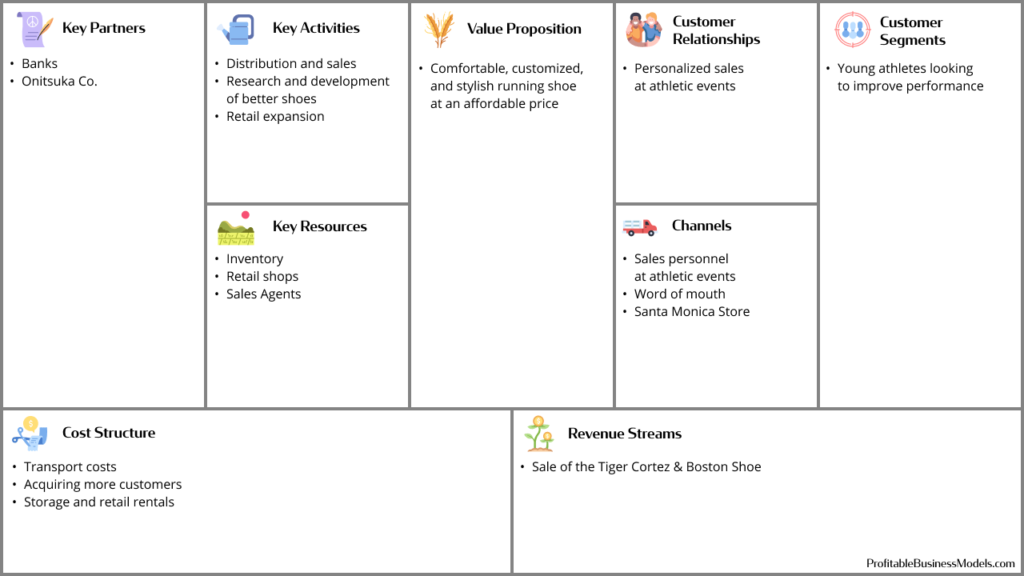
1971-1980: Nike Inc. is born
1971: The birth of Nike & Expansion
Unfortunately, Onitsuka’s shipment process began to cause too many issues for Bowerman and Knight. When the two discovered that their Japanese counterpart was feeding their local market first and sending the leftovers to America, this created friction between the two parties.
It was extremely frustrating for Knight and Bowerman because the arrangement kept them in a constant state of negative cash flow. They had very little capital to pay for expansion, so they entered into an agreement with a Japanese trading company called Nissho Iwai Corporation, which loaned them the money they needed.
This allowed Blue Ribbon Sports to manufacture its own line of products using overseas independent contractors. At this time, Bowerman and Knight decided to rebrand, but it was Jeff Johnson who came up with the name Nike. They paid a Portland State University student named Carolyn Davis to provide sketches of the logo and eventually settled on the Swoosh design, which they paid $35 for (today having a worth of $26 billion alone).
Johnson was responsible for the Nike marketing campaign that included brochures, print ads, and catalogs. He was a vital element of the campaign’s early success and was pretty hands-on. He shot the photographs for the catalogs and even designed some of Nike’s early shoes. This early adoption of an aggressive marketing campaign was the foundation that strengthened the Nike brand.
1972: Nike Splits from Japanese Partner, debuts new line of shoes
With their own distribution channels in place and enough capital to manage their operations, Nike split from their Japanese partner. Onitsuka Co. filed a lawsuit claiming that Blue Ribbon Sports (now Nike) was selling their shoes without permission.
The judge ruled that both companies could sell their own versions of the shoe, and Nike concentrated on expanding its brand. The U.S. Track and Field Trials were coming up, and Nike wanted to debut a new footwear line in time for this event.
Bowerman was still trying to create more new designs, and one day as he was having breakfast, inspiration once again struck him. He was looking to design a shoe that would give athletes more traction, and as he looked down at the waffle his wife had made him, he got an idea. He wanted to invert the grooves to give the sole a waffle-like design for better traction without adding weight.
The idea worked, and Nike debuted the Moon shoe just in time for the Track and Field event. But there was one problem. How would Nike get the word out about their new design? Adidas was still the dominant product.
By the end of 1972, the company had made over $1.96 million in sales revenue. It had doubled its staff from 20 to 45 employees and now had enough capital to expand its operations into Canada.
1974: The first official brand ambassador & endorsement & first U.S. manufacturing plant
Nike opened its first U.S. plant in Exeter, New Hampshire, and expanded its staff to 250 employees. The worldwide sales neared $5 million by the end of 1974 due to the company’s aggressive marketing campaigns.
The company looked for an athlete who could endorse and bring awareness to Nike’s new line of track shoes. This was a completely new marketing strategy because up until this point there was no one who was using endorsement
A young man named Steve Prefontaine agreed to be Nike’s first brand ambassador for $5,000. He was the right man for the job because he had never lost a race in his hometown. He was quickly gaining national exposure due to being on magazine covers like Sports Illustrated.
Nike also signed its first professional athlete, Romanian tennis player Ilie Nastase that year. They created their first promotional tagline, “There is no finish line,” which accompanied every appearance that their athletes made. Prefontaine, in particular, played a crucial role in the success of Nike’s first marketing campaign, sending several pairs of Nike’s shoes to other runners along with personal notes.
That same year Nike released its version of the Cortez at the Mexico Olympics. By that time, the name Nike was attached to the careers of successful athletes. The message and value proposition was clear. If you were a serious athlete looking for a shoe to help you perform better, you had no choice other than Nike.
Nike’s aggressive marketing strategy had been consolidated. It was clear from this early campaign that they had to invest in and build their brand using emotional marketing, sports endorsements, and high-quality, innovative products.
1975-1979: Global Expansion & controversy
Nike’s growth really took off in the late 70s. Aside from its successful advertising campaigns, the company benefited from the rise of jogging in the country, a trend which had started after WWII when there was a move towards non-organized, individualistic physical and recreational activities. Sales revenue by the end of 1976 was sitting at $14 million. It doubled to $28 million in 1977.
Nike opened up several new factories around the world. They added a stitching plant in Maine and several production facilities in Taiwan and Korea. The company ventured into the Asian market and opened new retail and distribution shops in the continent in 1977 and in South America and Europe in 1978. They also added a new line of products for children that same year.
In 1979 Nike had sold almost half of the running shoes purchased in the U.S. and debuted a new line of sports clothing. By the end of the year, Nike had a 50% market share in the U.S.
Nike’s Business Model Canvas: Expansion
At this point, Nike’s Business Model Canvas looked like this:
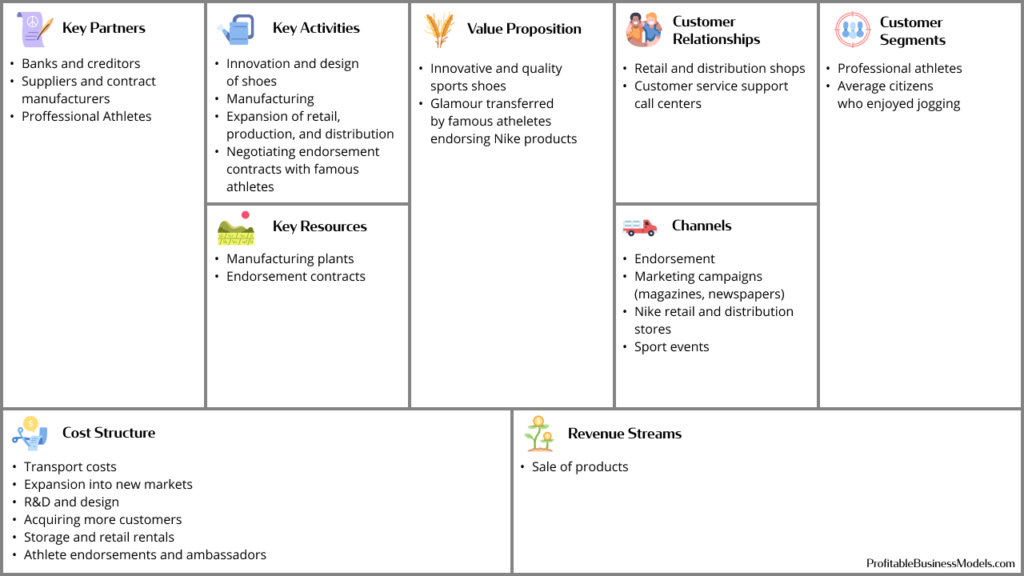
1980 – 1989: The Decade of Just Do It!, Michael Jordan, Going Public & Domination of the Sports World
By the 1980s, Nike had over 50% of the market, thanks to its groundbreaking designs and marketing campaigns. It had surpassed Adidas as the leading athletic shoe company in the U.S. In December 1980, Nike listed its IPO, offering two million shares of stock. Now the company had enough capital to keep expanding, especially in the European market.
1981-1982: Nike International Ltd & the European Soccer Market
Despite its success in the U.S., it became evident that growth in that market was slowing down. The jogging craze had waned, and the demand for running shoes was declining. Fortunately, by this time, Nike was well insulated due to its expansion into other sports shoes like basketball and tennis. They also had very successful lines of children’s shoes, work, and leisure shoes and clothing.
Nike incorporated Nike International Ltd to expand into Europe, Japan, Africa, Latin America, and Asia. The expansion was not smooth because they faced competition from Adidas and Puma, especially in Europe, where there was a strong soccer market. Nike opened a factory in Ireland, which helped them cut distribution and importation costs.
In 1982, Nike outfitted Ashton Villa, the team that went on to win the English and European soccer championships. Finally, Nike penetrated the soccer market and successfully reinvented itself as a soccer shoe manufacturer.
1983-1984: A Slow Decline & A Nation-wide Marketing Strategy
However, the victory was short-lived as the company posted its first-ever drop in earnings during the first quarter of 1983. While the expansion in Japan and Asia did well, Europe was a different story.
All five Nike subsidiaries in Europe were losing money, and things weren’t going too well back home either. The company’s traditional marketing strategy of supporting star athletes and sporting events seemed not to be cutting it anymore. Moreover, the company’s push into foreign markets and attempts to market its clothing line had cost a lot more than they had anticipated.
They decided to try a more aggressive approach and invested over $10 million in their first National T.V. ad, which was broadcast during the New York Marathon. They also bought advertising space in magazines and launched a ‘Cities Campaign’ using billboards and murals in nine American cities. They had mixed results, and by the time the 1984 Olympics arrived, profits were down almost 30%.
In an attempt to save the company, Nike executives decided to cut costs wherever they could. They started by consolidating their research and marketing departments and closing the Exeter, New Hampshire plant, which had been dedicated to that branch. They also laid off about 400 employees.
1985: Michael Jordan and Nike Air Jordan
Nike was facing significant challenges in 1985. Consumer tastes were changing, and people were moving away from jogging and more towards aerobics. The company created a new line of products to cater to this shift, and in addition, they acquired Pro-form, a small weight-lifting equipment maker.
Nike also did some restructuring by closing its last two U.S. factories and moving all production overseas where it was cheaper.
In a move that has been attributed to saving Nike’s dominance in the U.S. market, they entered into a deal with a young rookie basketball player called Michael Jordan. They designed the ‘Air Jordan’ as an adaptation of Nike’s Air shoe developed four years prior. (We don’t have to tell you how successful that partnership eventually became.)
1988-1989: Just Do It! Campaign & More Restructuring
In 1988, Nike launched the Just do It! slogan, which eventually became one of their signature tag lines.
However, they were still facing revenue challenges and engaged in restructuring and budget cuts from 1987 into 1988. The only product that was doing well was their Nike Air shoes which Michael Jordan had endorsed in 1985.
Right until the end of the decade, Nike was struggling for air. They expanded into the casual dress and shoe market by purchasing Cole Haan. This proved to be a great strategy as profits and sales began to increase. They also enlisted Bo Jackson, a famous baseball and football player. They launched a new cross-training shoe under the ‘Bo Knows’ campaign.
The ’80s had been a challenging decade for Nike, and while they had managed to survive, they had a lot more trouble coming their way in the 90s.
1990-1999: Opening of the First Nike Shop & Becoming More than Just a Footwear Brand
1990: NikeTown and New Headquarters
The first half of the 90s was good for Nike. They saw company revenues hitting $2 billion in 1990 and acquired Tetra Plastics Inc., which produced plastic film for shoe soles. That same year Nike opened its first full-range Nike Shop called NikeTown in Portland, Oregon. NikeTown sold all of Nike’s products under one roof. The company also moved to its new eight-building World Headquarters in Beaverton, Oregon.
1991: Reclaiming dominance
Nike’s Air shoes and partnership with Michael Jordan had allowed them to surpass Reebok in the U.S. market. The good news just kept coming when their efforts to penetrate the European market finally paid off. Revenue from sales in Europe peaked at $1 billion, and by the end of 1991, Nike was second in the market only to Adidas.
In 1992 Nike celebrated its 20th-anniversary debt-free and with over $3.4 billion of revenue worldwide. They also opened a second NikeTown retail store in Chicago. Expansion of Niketown continued into 1993, opening chain stores in outlets all across the U.S.
Nike as a Lifestyle Brand
The trouble of the 80s had shown Nike that they had to move beyond being just a sportswear brand. In the mid-90s, as part of its long-term business strategy, Nike partnered with Mike Ovitz’s Creative Artists Agency to create and package sports events under the Nike name. This put Nike in direct competition with sports management giants like ProServ, IMG, and Advantage International.
Nike also began inserting itself into the lives of the athletes it sponsored by negotiating sporting, investment, and apartment contracts. While others in this sports world frowned upon such an invasion, Nike argued that it was part of their campaign to create an image that Nike was more than a product. It was a lifestyle.
1994-1995: Continued Dominance, acquisitions, and Tiger Woods joins Nike
Right up to the end of 1995, Nike was doing well internationally and locally, scoring deals with various companies and individuals. In 1994 they partnered with Canstar Sports Inc., a leading manufacturer of skates and hockey equipment. Canister was renamed Bauer and eventually incorporated into Nike’s new equipment-making division. Nike ventured into protective gear, watches, eyewear, and sports balls.
In 1995 Nike signed Tiger Woods with a $40 million endorsement contract which would later prove Nike’s most lucrative endorsements after Michael Jordan.
1996-2000: Sweatshop controversy, loss of revenue, and reclaiming the top spot
Since the 1970s, Nike had been battling accusations of using sweatshops for manufacturing their products. Because Nike’s business model was built on finding the cheapest cost of labor, they had opened factories in Asia. These factories were prone to child labor and poor working conditions.
These simmering rumors finally came back to bite Nike when a report highlighted that some of Nike’s factories were sweatshops. This changed the public’s perception of the brand and led to a sharp decrease in sales. The Asian financial crisis of 1997 caused a ripple effect that saw sneaker sales plummet. By the end of the decade, Nike was posting losses of up to $67.7 million.
Nike in 1998 established a department called All Conditions Gear (ACG) to reclaim the top spot, which would cater to street fashion and extreme sport consumers. This department would produce clothing and shoes for skateboarders, snowboarders, and mountain bike enthusiasts.
In 1999, Nike began selling its shoes directly to customers using their website. It also purchased 10% of the sporting goods e-commerce site Frogdog Inc, selling Nike’s full line of products online.
In 2000, Nike also created a new division called Techlab to produce a line of sports-technology accessories. The new products included a high-altitude wrist compass, a portable heart-rate monitor, and digital audio players.
Nike had survived the worst, and with the help of strategic investments, adaptation to technology, and aggressive marketing, they managed to make an impressive comeback.
Nike’s Business Model Canvas: The 21st Century
At this point, Nike’s Business Model Canvas looked like this:
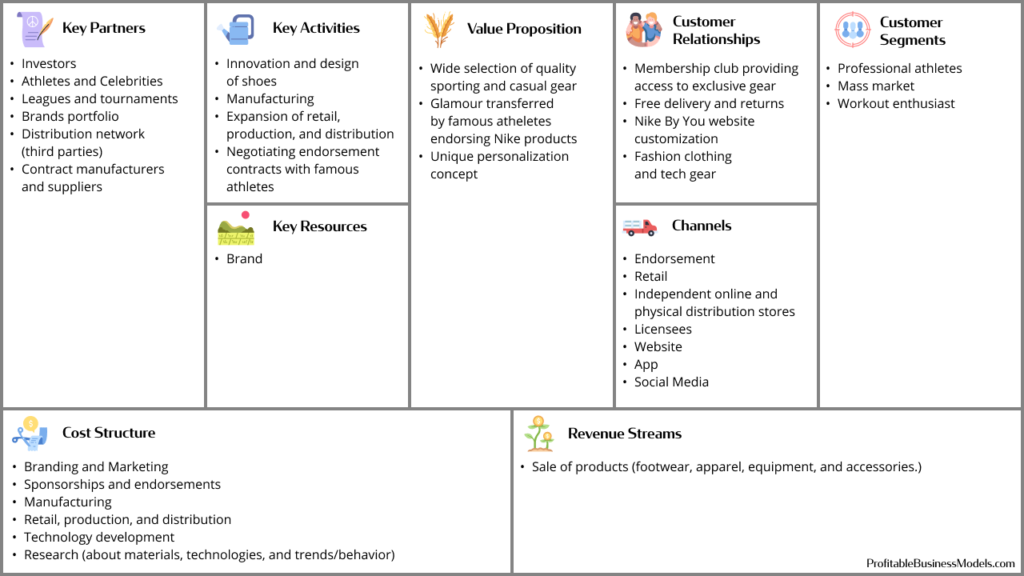
Conclusion
What’s fascinating about the Nike journey is their ability to accurately pinpoint problems in their business model and adapt to survive. When cash flow was a problem they solved it by going public. When their customer’s tastes changed, they developed new products, extended their services, and upped their marketing campaigns.
To this day, Nike continues to implement the same strategies. They focus on high-quality marketing campaigns, sports and celebrity endorsements, and innovative technology to make their shoes better and more advanced.

